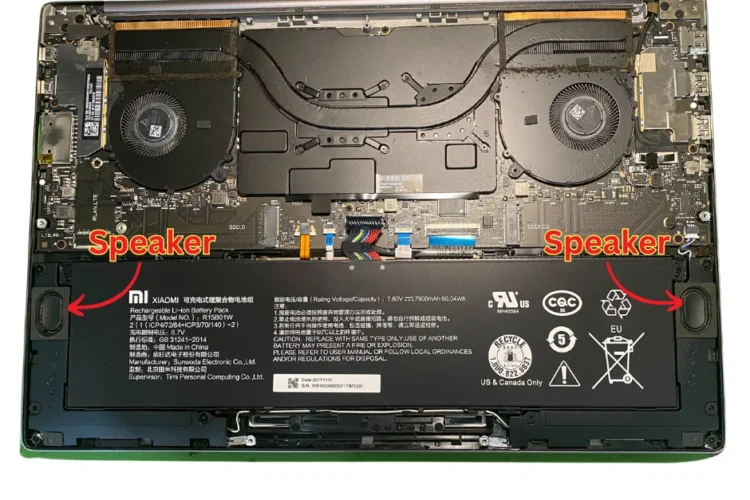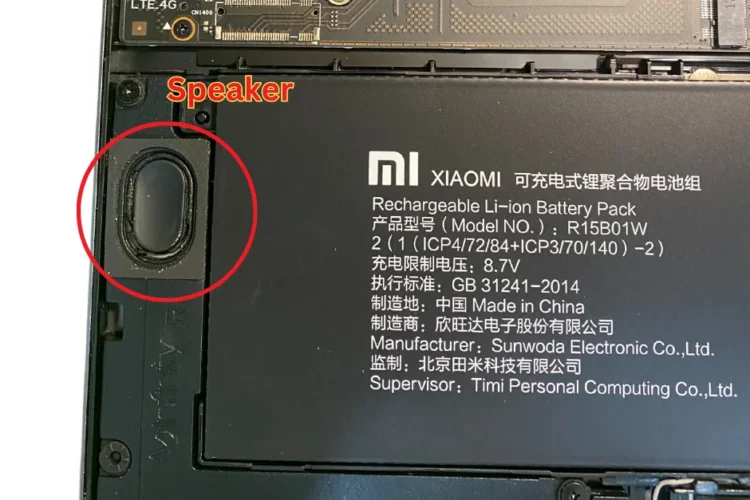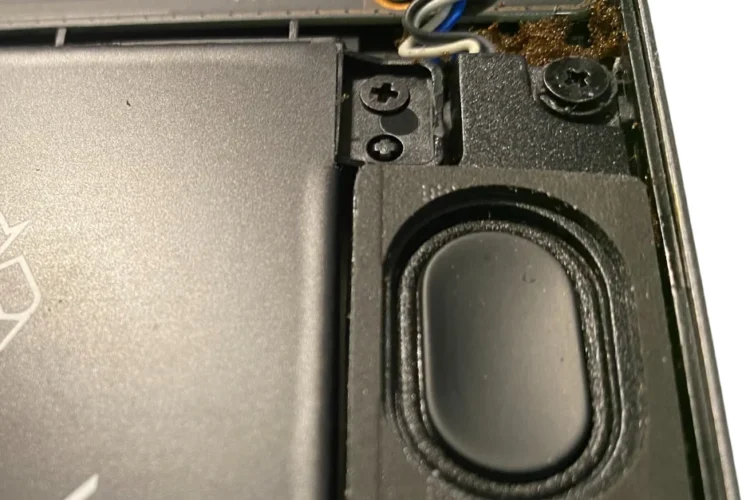Laptop repair, especially for audio issues, is essential in maintaining an exceptional user experience. This blog post will focus on a real case study of a customer who sent their Xiaomi laptop for speaker repair. By sharing this genuine example, we aim to provide valuable insights into diagnosing and fixing laptop speaker problems. Join us as we delve into the process and explore useful tips for addressing audio concerns, ensuring your laptop’s sound quality remains top-notch.
1. Understanding Laptop Speakers
a) Types of laptop speakers
- Integrated speakers: Firstly, integrated speakers are built into the laptop’s design, providing a seamless audio experience. While convenient, these speakers can be challenging to access for laptop repair.
- External speakers: On the other hand, external speakers are separate devices that connect to the laptop via USB, Bluetooth, or auxiliary cable. These speakers offer easy repair options and customizable sound quality.
Note: In this blog post, we focus exclusively on built-in or integrated laptop speakers, rather than addressing external speaker issues.
b) Common causes of speaker problems
- Hardware issues: Hardware issues often stem from factors like consistently playing audio at maximum volume or general wear and tear. Consequently, internal components may become damaged or loose over time. Identifying and addressing these hardware problems is crucial for a successful laptop repair, ensuring optimal speaker performance and user satisfaction.
- Software issues: In some cases, software issues, like outdated drivers or incompatible settings, may cause speaker problems. Regular updates and troubleshooting can help prevent these problems.
- User error: Lastly, user errors, including incorrect settings or improper speaker handling, can also contribute to speaker issues. Being mindful of proper speaker use is essential for optimal performance.
2. Diagnosing Laptop Speaker Problems
a) Preliminary checks
- Volume settings
Before diving into complex laptop repair, start with the basics. Firstly, locate the volume settings on your laptop, typically found in the taskbar (Windows) or menu bar (Mac). Alternatively, use the volume keys on your keyboard. Ensure the volume is set to an audible level. In some cases, a simple volume adjustment can fix the issue.
- Mute function
Similarly, check if the mute function is accidentally enabled by looking at the speaker icon in the taskbar (Windows) or menu bar (Mac). If the icon has a cross or a slash, it indicates that the speakers are muted. To unmute, simply click on the speaker icon and adjust the volume slider, or use the dedicated mute/unmute key on your laptop’s keyboard. Unmuting the speakers can quickly resolve the problem without needing any technical expertise.
- Audio output settings
Lastly, verify the correct audio output is selected. Sometimes, the laptop might route sound to other devices, such as headphones or external speakers. Correcting the output setting will restore sound to the laptop’s speakers.
b) Identifying hardware issues
- Physical inspection
For hardware-related problems, start with a thorough inspection. First, find your laptop’s speaker location in the user manual or online. Before opening the laptop, power it off and unplug it. Use appropriate tools and ground yourself to avoid static discharge. Look for visible damage or loose connections, indicating laptop repair needs. If uncomfortable with opening the laptop, seek professional help.
- Using diagnostic tools
Moreover, diagnostic tools help pinpoint hardware issues.
If updating drivers still yields no sound, consider uninstalling and reinstalling the audio driver. Alternatively, try a system restore to a previous date when sound worked properly. If issues persist, seek professional laptop repair assistance.
c) Identifying software issues
Outdated drivers can cause speaker issues. To resolve this, check for available updates and install them accordingly. Regular driver updates can prevent future software-related speaker problems.
For instance, Windows users can access the built-in “Device Manager” to test speaker performance. To access, right-click the “Start” button, select “Device Manager,” and expand “Audio inputs and outputs.” Then, right-click on the speaker device and choose “Properties.” Navigate to the “Driver” tab and select “Update Driver” to check for updates. Running these tests offers valuable insights for laptop repair.
For Mac users, updating drivers involves updating the macOS itself. Firstly, click the Apple menu and choose “System Preferences.” Next, select “Software Update” to check for available updates. If updates are found, follow the on-screen instructions to install them.
If updating drivers still yields no sound, consider uninstalling and reinstalling the audio driver. Alternatively, try a system restore to a previous date when sound worked properly. If issues persist, seek professional laptop repair assistance.
3. Laptop Repair Solutions for the Speakers
a) Hardware repairs
- Replacing damaged speaker
If speakers are damaged, replacing them is the best solution. Firstly, consult your laptop’s manual or search online for compatible speaker replacements. After acquiring the necessary parts, follow the manufacturer’s guidelines for installation.
- Repairing loose connections
Sometimes, speaker issues arise from loose connections. In such cases, open the laptop and inspect the wiring. If you find any loose connections, carefully reconnect them. Ensure proper placement before reassembling the laptop.
Again, if you’re uncomfortable with this task, professional laptop repair services are available to help. Handling hardware repairs demands skill and precision. Without proper knowledge or tools, you may damage other laptop components, causing bigger issues. To avoid problems, either learn correct repair techniques or rely on professional laptop repair services. Trusting experts saves time, money, and prevents further damage to your device.
b) Software solutions
- Reinstalling audio drivers
Reinstalling audio drivers can resolve software-related speaker problems. Uninstall the current driver from the “Device Manager” (Windows) or “System Information” (Mac), then download and install the latest version from the manufacturer’s website. Restart your laptop to apply the changes and check if the issue is resolved.
Reinstalling audio drivers can resolve software-related speaker problems. However, be cautious when uninstalling drivers from the “Device Manager” (Windows) or “System Information” (Mac). If done incorrectly or without proper knowledge, you might uninstall the wrong driver, causing your laptop to malfunction. To avoid such issues, ensure you’re skilled in driver management or consult a professional laptop repair service for assistance.
- Updating the operating system
An outdated operating system may cause speaker issues. Regularly update your Windows or macOS to ensure compatibility with the latest drivers and software. This simple step can prevent many software-related speaker problems.
c) When to seek professional help
- Complex hardware issues: For complex hardware issues, like damaged internal components or intricate wiring, seeking professional laptop repair is highly recommended. Expert technicians have the necessary skills and tools to diagnose and repair these issues safely and effectively.
- Persistent software problems: If software problems persist despite your efforts, it’s time to consult professional laptop repair services. They have the expertise to identify and address stubborn software issues, ensuring your laptop’s speakers function optimally.
4. Laptop Repair Case Study: Xiaomi Speaker Fix at Volta PC Upgrade & Repair
In a recent case, a Xiaomi laptop’s speakers suffered from wear and tear. The customer brought the device to Volta PC Upgrade & Repair (FKA BudgetPC) for a free diagnosis. Our skilled technicians quickly identified the root cause and helped the customer order a replacement part. The speaker replacement process took less than 2 hours.
Here are some photos of the damaged Xiaomi Laptop Speaker:



5. Preventing Future Laptop Speaker Issues
a) Regular maintenance
- Cleaning speakers: Keep your laptop speakers clean by gently removing dust and debris. This simple maintenance step helps prevent speaker damage and extends their lifespan, reducing the need for laptop repair.
- Updating software: Consistently update your laptop’s software to ensure optimal speaker performance. Take note of the equalizer settings as well, adjusting too much of base and treble will cause damage to the speakers as well. In a nutshell, regular updates allows you to have the latest software that might help prevent software-related speaker issues and potential laptop repair.
b) Best practices for speaker usage
- Avoiding excessive volume: To protect your laptop speakers, avoid consistently using maximum volume. Excessive volume can damage the speakers over time, leading to costly laptop repair.
- Proper handling of external speakers: If using external speakers, handle them with care. Ensure secure connections and store them safely when not in use. Proper handling helps avoid damage and unnecessary laptop repair.
Conclusion
In sum, proper speaker maintenance and usage can prevent many laptop speaker issues. By following these guidelines, you can extend your laptop’s speaker life and enhance your audio experience. However, if you encounter any speaker problems or need professional laptop repair in Singapore, don’t hesitate to contact Volta PC Upgrade and Repair (FKA BudgetPC). Our experienced team is ready to diagnose and resolve your laptop speaker issues, ensuring top-quality sound and performance.
